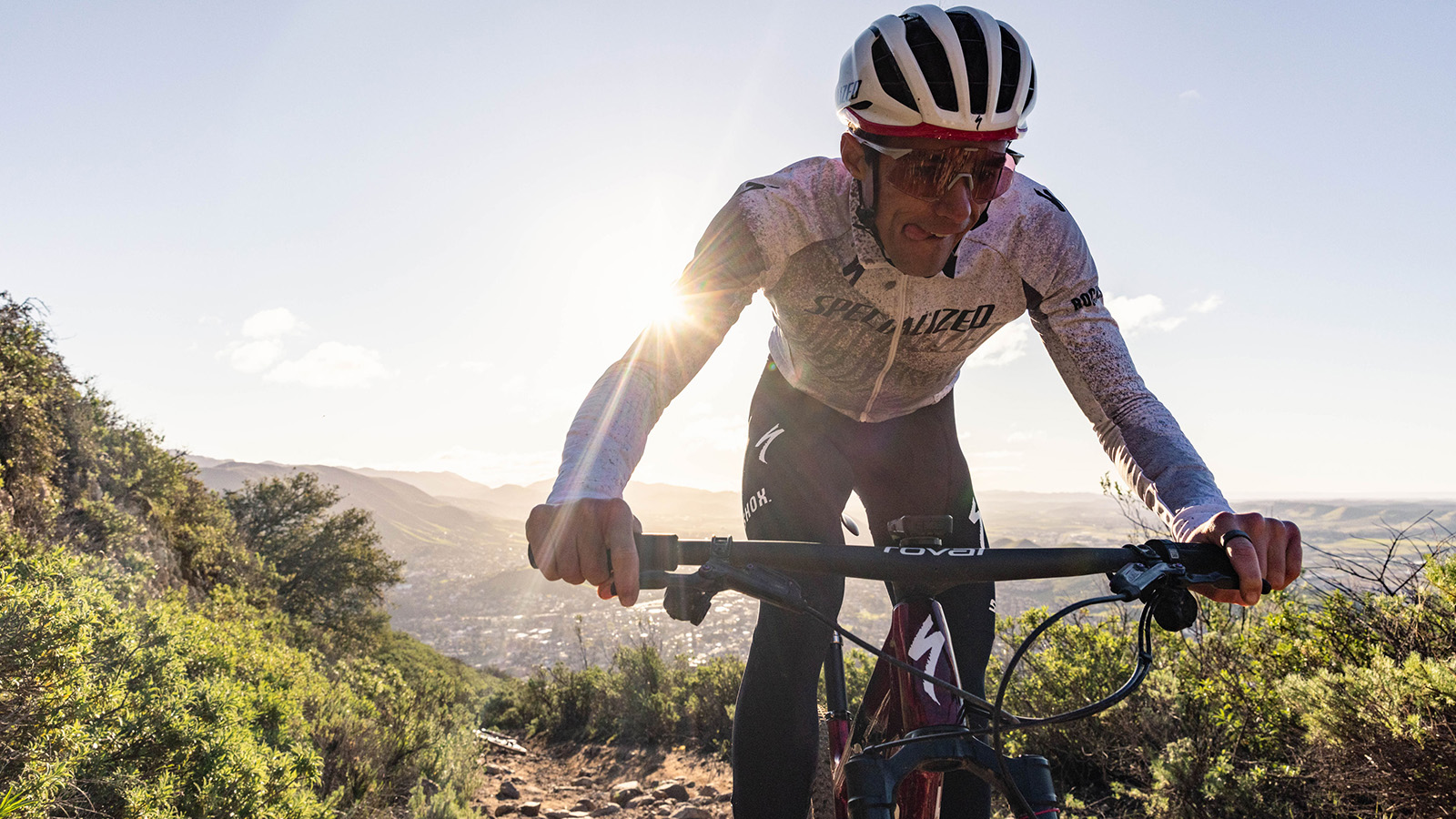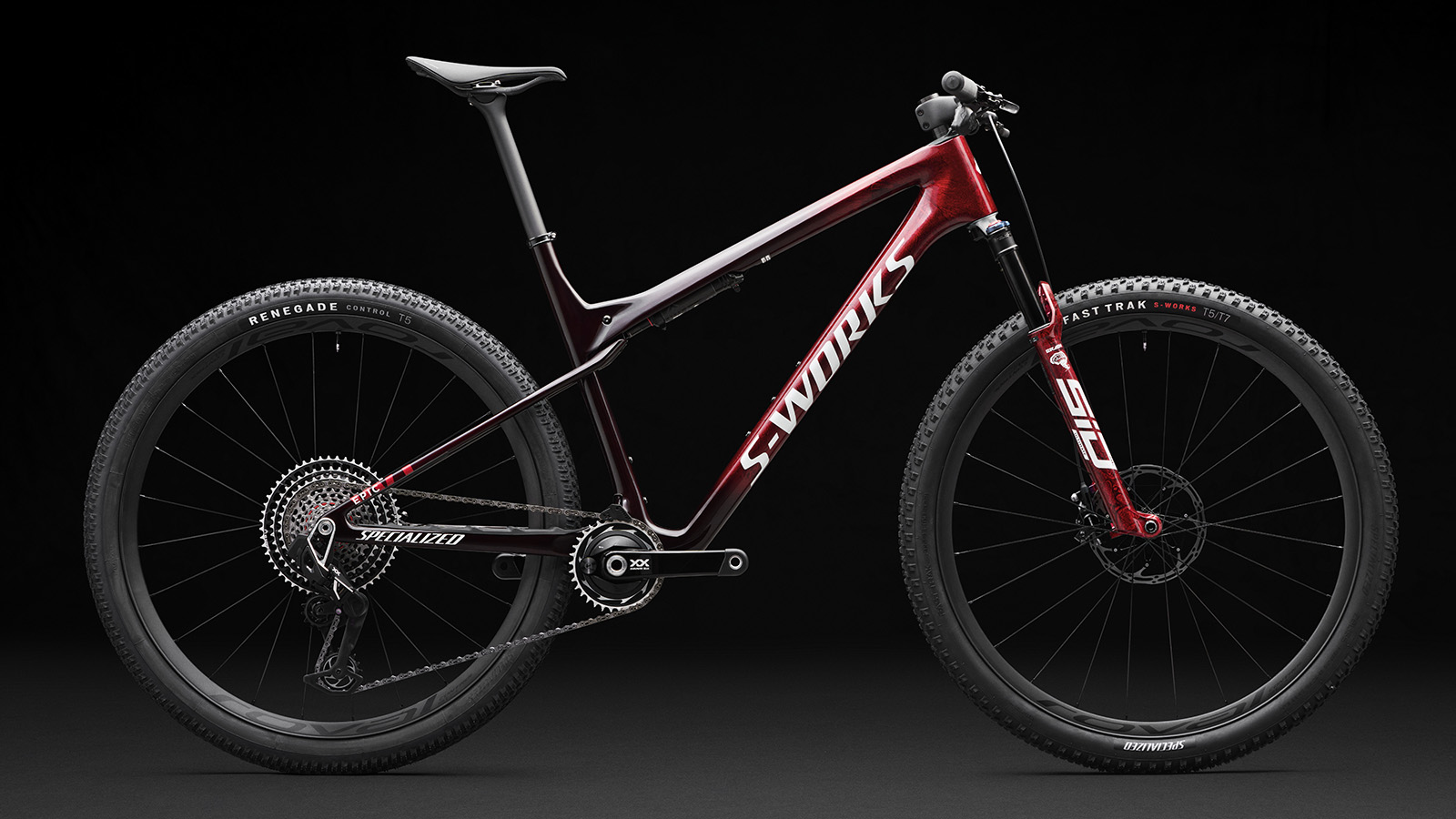Specialized kill off the Epic and replace it with the Epic World Cup that's got a frame a kilo heavier!
Specialized has ended production one of the best XC race hardtails ever after 33 years and the frame that replaces it weighs a lot more. Is this ‘Innovate or Die’ at its most progressive or most suicidal?

Specialized hasn’t been shy about leaking sneaky peaks of its new Epic World Cup bike. It was raced and pit papped with a shock cover on months ago, and it was the star of the recent SRAM Eagle Transmission launch in all its naked glory.
The new Epic is just part of a flurry of Specialized announcements today, with the US brand also revealing updated versions of their 2FO Roost Flat shoe including a brand new street Method model, a redesigned Purgatory tire range and the Dissident 2 full-face helmet.
Given that Specialized’s Epic range is one of the most popular and ‘winningest’ race families ever, that created a lot of coverage. A lot of that was to do with the similarity of the ‘shock hidden in the top tube’ design to Trek’s Supercaliber bike, potentially making the new bike the ‘whingingest’ bike ever before it even officially launched.
Now that we’re allowed to talk about it, there are some clear differences that hold truer to Specialized’s old ‘Innovate or Die’ adage. The Epic World Cup's suspension system uses a new RockShox SID WCID damper that uses a short linkage rather than a unique Fox shock/slider design embedded in the seat stay head. Both the new Epic World Cup S-Works and Pro models feature 75mm of rear travel – which is 15mm more than the Trek – and come with a very distinctive triple setup strategy.

This uses a “revolutionary” independently adjustable air spring to offer zero sag ‘Firm’, 2.5 percent sag ‘Medium’, and 4 percent ‘Active’ settings. It’s only “revolutionary” if you don’t remember that's how the original RockShox SID shock worked and that Giant had an NRS system in the late '90s that was based both around that shock and a zero sag strategy. There’s no sign of any remote lockout lever either and with the system being set up pressure based, we can only presume that riders will just have to choose what setting they want for the whole race rather than being able to change modes on the fly.
Returning to the chassis, the shock also has wide stance bushings to help it act as a structural member. Specialized says the double diamond frame layout has been leveraged to achieve “new standards in torsional rigidity (for steering precision and upper body power transfer) and BB stiffness (for pedal response and efficiency)”. Add a shock that’s effectively totally topped out in some settings, Roval’s new super stiff XC gear including a fixed length rather than dropper seat post, and this sounds like it’s going to be an unapologetically brutal speed-focused machine.
The head angle is far slacker at 66.5 degrees too which sets up the same aggressive handling vibe as Specialized’s Epic Evo ‘XC party bike’ so you can bring the speed to the descents too. According to both manufacturers' figures, new Epic S-Works is also 135g lighter than the Supercal which is a big deal if you’ve got the typical gram geek mindset of an XC racer.

Cross-country cull
So far, this all sounds exactly what racers are after – stiffer, lighter, more confident handling – but that’s where the new Epic S-Works launch gets really interesting/controversial. Most pre-release online chat presumed that the new bike replaced the ‘BRAIN’ equipped ‘automatic suspension’ Epic FSR model that Specialized has been evolving – and racers have been winning on – for 20 years. The shock news is that according to Specialized, the Epic FSR stays, but the Epic S-Works hardtail will go.
So why is this a big deal? Well MTB history buffs will know the Epic hardtail has been in the Specialized range for over 30 years since appearing as a limited edition titanium and carbon fiber superbike. Despite being four years old, the current Epic S-Works hardtail is still one of the lightest race frames around at 775 grams for a medium. That's a kilo lighter than the new Epic World Cup frame. In fact, at 1,765g for a medium, the new 75mm travel frame is 106g heavier than the existing 110mm travel Specialized Epic Evo S-Works that it essentially shares the same geometry with. At a breathtaking £5,500 for the frame, £8,500 for the Pro model and £12,000 for the complete S-Works bike, you’re not saving any cash either.
While Specialized has presumably done the maths on sales of its current race hardtail range before killing it off, it still seems odd when Scott told us that sales of the similar Scale race hardtail range accounted for half of its global MTB sales in 2022. The top tube shock mount of the Epic S-Works makes it a lot less suitable for using as a bikepacking bike, which is where we’re seeing massive growth in the uptake of XC MTBs as riders realize the limits of even the most progressive bounce loaded gravel bikes like Specialized’s Diverge.
As we haven’t actually ridden the new bike yet we can’t comment on how fast it is at the bleeding edge of an XC race which obviously matters more than grams and travel to real athletes rather than armchair ones. According to Specialized Pro Racer and ex Short Track World Champion, Christopher Blevins, “The first time I rode the Epic World Cup, I knew I’d never ride a hardtail again. This thing’s a hardtail killer…” He’s not just talking about Specialized’s range decisions going forward either as he continues, “it gives me everything I could want from a hardtail, plus the control and capability of full-suspension”. Having three XC full-suspension bikes in a 200g frame range with 75mm-110mm travel definitely gives racers a rich vein to choose from if they want full-sus too. Killing its race hardtail range in favor of a bike that has less travel than an existing lighter option is undoubtedly a controversial move though, so we can’t wait to get a sample of the new World Cup to fully understand where Specialized is coming from.
Specialized Epic World Cup pricing and release
The Specialized Epic World Cup is available now in S-Works, Pro and frame only options, costing $12,000 / £12,000, $8,900 / £8,500 and $6,500 / £5,500 respectively and are available now. For more info, head to Specialized.com
Tech specs: Specialized Epic World Cup

Epic World Cup S-Works
- Frame: S-Works FACT 12m Carbon, WCID suspension design, threaded BB, 12x148mm UDH hanger
- Fork: RockShox SID SL ULTIMATE BRAIN, Top-Adjust Brain damper, Debon Air, 15x110mm, 44mm offset, 110mm travel
- Shock: RockShox-Specialized SIDLuxe WCID Ultimate, Ride Dynamics Developed, Independent negative spring, Rebound Adjust, 215x40mm, 75mm travel
- Bar and stem: S-Works Carbon XC Mini Rise, 6-degree upsweep, 8-degree backsweep, 10mm rise, 760mm, 31.8mm, Specialized Pro SL, alloy, 4-bolt stem
- Brakes: SRAM Level Ultimate, 2-piston caliper, hydraulic disc, stealth,180/160 or 180/180mm rotors
- Crankset: Quarq XX SL power meter, carbon, 168 Q-Factor, DUB,170/175mm, 34T
- Gearing: SRAM POD AXS controller, SRAM XX SL Eagle Transmission derailleur, SRAM CS-1299, 12-speed, 10-52t cassette
- Wheels: Roval Control SL hubs and DT Swiss Internals with ceramic bearings, Roval Control SL carbon rims, 29mm internal width
- Tires: Specialized S-Works Fast Trak, S-Works Casing, T5/T7Compound, 29x2.35 front, Specialized Renegade, Control Casing, T5 Compound, 29x2.35 rear
- Saddle: Body Geometry S-Works Power, carbon fiber rails, carbon fiberbase
- Seatpost: Roval Control SL carbon, two-bolt clamp, 0mm offset,415/370mm x 30.9

Epic World Cup Pro
- Frame: Fact 11m carbon, WCID suspension design, threaded BB, 12x148mm UDH hanger
- Fork: RockShox SID SL ULTIMATE BRAIN, Top-Adjust Brain damper, Debon Air, 15x110mm, 44mm offset, 110mm travel
- Shock: RockShox-Specialized SIDLuxe WCID Ultimate, Ride Dynamics Developed, Independent negative spring, Rebound Adjust, 215x40mm
- Bar and stem: Roval Control SL Integrated cockpit, 60mm/70mm X- 12 degree integrated stem, 8-degree backsweep, 1- degree upsweep, 760mm wide
- Brakes: SRAM Level Silver, 2-piston caliper, hydraulic disc, stealth,180/160 or 160/160mm rotors
- Crankset: SRAM XO Eagle, Quarq Spindle power meter, DUB,170/175mm, 34T
- Gearing: SRAM POD AXS controller, SRAM XO Eagle Transmission derailleur, SRAM XS 1295, 12-speed, 10-52t cassette
- Wheels: DT Swiss 350 hubs, Roval Control SL carbon rims, 29mm internal width
- Tires: Specialized Fast Trak, Control Casing, T7 Compound, 29x2.35 front, Specialized Renegade, Control Casing, T5 Compound, 29x2.35 rear
- Saddle: Body Geometry Power Expert
- Seatpost: Roval Control SL carbon, two-bolt clamp, 0mm offset,415/370mm x 30.9

Guy Kesteven has been working on Bike Perfect since its launch in 2019. He started writing and testing for bike mags in 1996. Since then he’s written several million words about several thousand test bikes and a ridiculous amount of riding gear. He’s also penned a handful of bike-related books and he reviews MTBs over on YouTube.
Current rides: Cervelo ZFS-5, Specialized Chisel, custom Nicolai enduro tandem, Landescape/Swallow custom gravel tandem
Height: 180cm
Weight: 69kg
